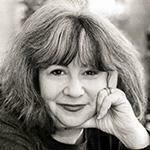Joan Roth
2020 Manhattan Jewish Hall of Fame Inductee
Biography
Early photographs chronicling the Second Wave Feminist movement brought insight to Jewish feminists (my focus) and led me to an even deeper search for my own identity. This work resulted in the groundbreaking photographic essay and ethnographic study, dating from the early 1970s, until today, about Jewish Women worldwide, published as a coffee table book, Jewish Women; A World of Tradition and Change, in 1985, accompanied by a 10-year traveling exhibit worldwide. In addition, I published the first Jewish women's Rosh Chodesh Calendar, In The Merit of Women, and the first-ever Sabbath Candle-Lighting poster, A Special Kind of Light.
Joan Roth's camera, writes the National Women's Division Of United Jewish Appeal, Lion of Judah Conference, Washington, DC, 1993. has helped us to understand … to see in the most moving way .. that while we're helping millions of out people, saving thousands of Jews, we're also reaching out to individuals, to single souls one at a time. Through Joan Roth's moving sensitive eye, you'll meet some of them in an unforgettable tribute to Jewish women.Read More
Feminist icon, Gloria Steinem, writes the following about my photographs of Jewish women taken in Ethiopia (before airlifts) Yemen, Bukhara, India, Israel, etc… Joan Roth has looked at the Jewish world as if women mattered – and therefore as if everyone mattered. Across all boundaries of geography and language, there is not only a common world of belief, but a common world of women. We see into its intimacy through her eyes.
The, Alice Shalvi, President Emerita of the Israeli Women's Network, wrote the following in a review about my exhibit at Beit Hatfusot Musseum of The Jewish Diaspora, in Tel Aviv: [Joan Roth] has the gift for seeing the significant moment, the meaningful gesture, and the fleeting look, which convey an in-depth character, a lifetime of experience, and an entire culture. [Her] gaze is a female gaze and, in the capacity to penetrate below the surface to the essence of women's lives, it is a feminist gaze, which does not objectify, but rather empathizes, sympathizes, and identifies with the subjects of her work.
As a photographer, I was among the first to photograph such notable events as the first National Women's Conference in Albany, New York, the 1977 International Women's Year Conference in Houston, Texas and the 1985 United Nations End Decade World Conference for Women in Nairobi, Kenya on a grant from the Ford Foundation, and, again in 1995 @ Beijing, China, for the Fourth World Conference for Women, and more, including the White House Conference on the Family; Hamtramck, Yesterday, Today and Tomorrow, a project funded by the National Endowment for the Humanities, as well as electoral mayoral campaigns of Reps. Bella Abzug and Ruth Messenger.
Additional groundbreaking projects include civil rights photo essays essay, I'll Come To Your House, If You Come To Mine, about integration of black and white students in NYC, exhibited at the 92nd Street Y, photographs of Jewish, Christian and Muslim Women in Israel, exhibited at the Spertus Museum in Chicago, Illinois, funded by the Illinois Arts council, The Chicago Offices of Fine Arts, and more; and most notable photographs documenting and interviewing homeless women, living on the streets of New York City, in the 1970s until today.
At a time of little interest and no understanding of what was happening, in the 1970s, I was known as a the leading photographer in uncovering the problem of homelessness among women My work helped develop the rationale for outreach programs and housing for homeless women which resulted in the book, Shopping Bag Ladies of New York, photographs were collected & exhibited by Museums and libraries worldwide and exhibited worldwide.
Harriet Lyons, editor at Ms. Magazine, wrote, In her book, Shopping Bag Ladies of New York (1982), Roth debunked the myth that women living on the streets were eccentrics, colorful characters who had chosen this lifestyle. Through powerful imagery and reporting, the Shopping Bag Ladies of New York had a convincing impact on city agencies that these women were indeed either down on their luck or mentally ill and their needs for medical attention, housing and other services virtually ignored.
Ed Geffner, then Executive Director of the Manhattan Bowery Project, now Project Renewal, who worked with homeless men and who recruited me to develop project on homeless women wrote the following over the years,
Joan Roth was a pioneer in uncovering the problem of homelessness among women. She photographed and interviewed many women living in the streets in the 1970s, a time of little interest and virtually no understanding of what was happening to these women and contributed invaluable information about the way they live, and how some of them become homeless.
Back when we were known as Manhattan Bowery Corporation, we received a grant from the Fund For The City of New York to explore ways to address this rising concern. We hired Ms. Roth as the principal investigator because she as one of the first people to investigate the issue. Her work called public attention to what turned out to be the tip of the iceberg of an important social problem. We have continued to work in the field of adult homelessness and consider Ms. Roth's early reports to be of significant value.
As the Principal investigator, Ms. Roth research in preparation for the Fund's 1983 report entitled, Shopping Bag Ladies: Homeless Women helped to develop the rationale for providing outreach services and housing options to homeless women.
As CEO of Project Renewal, I have known Ms. Roth for many years and can vouch for her dedication to and concern for homeless women, as well as her ability to expose new trends and issues related to the ongoing problem through her images and reporting.


